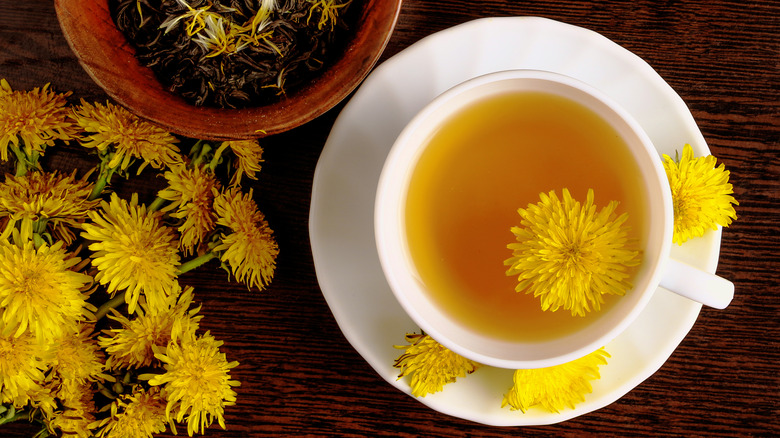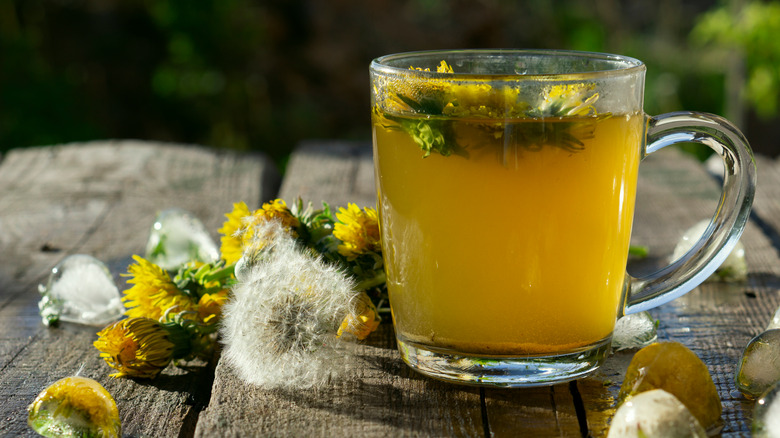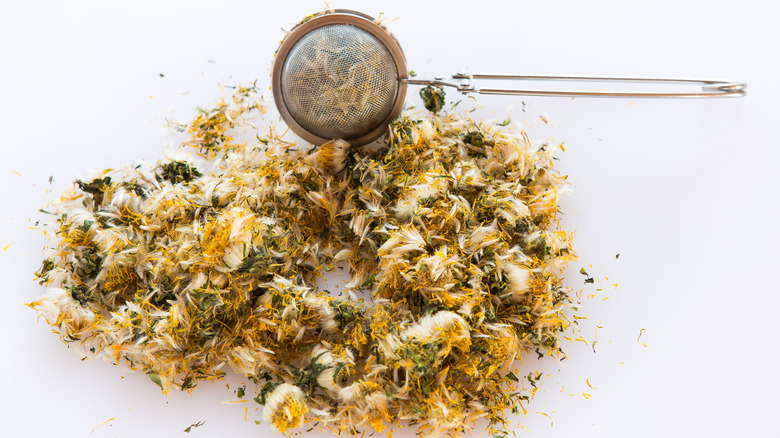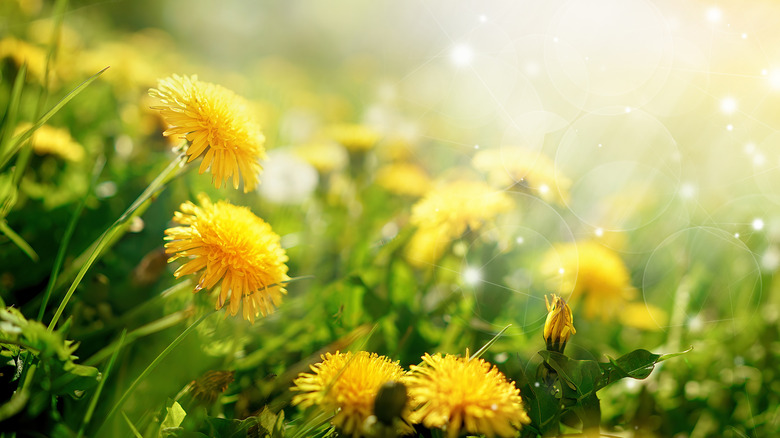What Is Dandelion Tea And Why Should You Drink It?
The bright yellow flowers of the dandelion plant can be a cheerful sight, even if they do grow everywhere you don't want them to. While a weed is basically just a plant that grows where it's not wanted, these hardy sunshiny blossoms border on invasive, the bane of many a gardener's existence. But what a lot of people don't realize is that dandelions and their leaves have significant nutritional benefits and have been consumed by humans for centuries.
As Food Print wrote, dandelions have been used in Chinese medicine for eons to promote liver health and as a diuretic. The Pilgrims relished them as one of the earliest spring crops, and the French even battered and deep-fried them, according to the Tahlequah Daily Press. Other groups like the Celts made dandelion wine from fermented petals, while Japan Times points out that dandelions were used by medieval herbalists as far back as the 10th and 11th centuries to treat everything from boils and ulcers to jaundice and gallstones (via Mostly Medieval).
While many people have eaten the blossoms and bitter greens in salads, one of the easiest ways, Parade noted, is to drink it in a tea. Although dandelion tea is often used as a substitute for other hot morning beverages, one of its advantages — or disadvantages, depending on the drinker — is that it contains no caffeine.
Dandelions rock the nutritional charts
From a nutritional perspective, dandelions and their greens pack a hearty wallop. Along with being full of vitamins A, K, C, and E, they also contain folate and some B vitamins (via Healthline). In addition, there are tons of essential minerals like calcium, potassium, magnesium, iron, and zinc, and they're also high in fiber, which aids in gut health. Dandelions are also full of antioxidants, including beta-carotene and polyphenols.
They also have a lot of other health bonuses. Some studies indicate dandelions can help reduce inflammation, improve digestion, and potentially improve cardiovascular function, lower blood pressure, and decrease blood cholesterol levels. It also has noted benefits to detoxify and improve liver function. A study published in The Review of Diabetic Studies suggested that it can aid in managing type 2 diabetes and controlling sugar levels. However, because of its laxative and diuretic properties, Well + Good notes, you need to start slow and build your tolerance over time, so you don't overwhelm your digestive system.
Dandelion tea is also low in calories. According to WebMD, a cup of raw dandelion is only 25 calories, with 1.5 grams of protein, 5.1 grams of carbs and 1.9 grams of fiber.
Dandelion tea is not complex to make
Dandelion tea is, generally speaking, made primarily from the flowers of the dandelion. The stems and greens can also be eaten, and some like them in the tea, but they tend toward an unpalatable bitterness in a beverage. As Japan Times points out, the flower head of a dandelion is actually a grouping of hundreds of small flowers, and those are what needs to be picked for the tea.
To make a basic fresh flower dandelion tea, Mama's Homestead writes, take a handful of the flower heads, put them in a tea ball, and steep them in boiling water for 20 minutes. However, they also note you can dehydrate the flower leaves — either in a dehydrator or in direct sunlight — for a less bitter tea with a faster steeping time (via Sencha Tea Bar).
Along with raw or dehydrated flowers, Well + Good notes you can also make tea from roasted dandelions, particularly the root. Where tea from raw plants has a light, semisweet floral flavor, the roasting gives a more coffee-like feel, with a smoky, toasted flavor and a bitterness and color people expect from their morning cup of joe. Store your fresh, roasted, or dehydrated dandelion in airtight jars for maximum flavor and keep out of the sunlight.
If you're going to be making a lot of dandelion tea, you should look for dehydrated blossoms.
It's not just as simple as picking your weeds
If you're wanting to create your own dandelion tea, it's good to know that not all dandelions are created equal. Food Print points out that Japan's National Dandelion Society curated over 200 different varieties of dandelions. According to Japan Times, they're actually in a flower family related to daisies.
If you are going to be harvesting your own dandelions, make sure they're being grown in a place that is not treated with pesticides or other chemicals. Preferably, you'll be able to purchase them at an organic grocery or a farmers market. You can pick from your own backyard if you know they're chemical-free. However, if that's not an option, forage for plants in untreated meadows and yards, away from high traffic areas like the roadside, Food Print stresses, as you don't want to ingest any plants that have been coated with soot or exhaust.
However, don't just grab a bunch, throw it in hot water, and be done, Well + Good suggests, because the plant's bitterness can be unpalatable. Rather, buy established tea blends or follow existing recipes until you know enough about the plant to experiment with adding other herbs and flavors. Stevia, honey, or other sweeteners can also be added to counter the bitterness. Additionally, use the youngest blooms, as they're usually less bitter, while they're still fresh.



